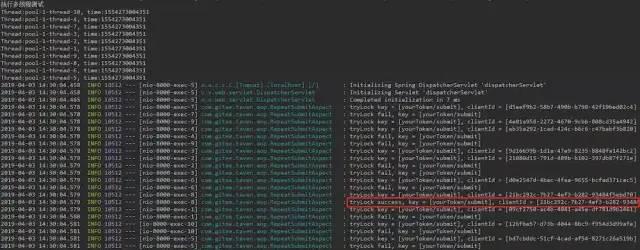Spring Boot 使用 AOP来防止重复提交,
分享于 点击 6817 次 点评:107
Spring Boot 使用 AOP来防止重复提交,
-
自定义注解 @NoRepeatSubmit 标记所有Controller中的提交请求
-
通过AOP 对所有标记了 @NoRepeatSubmit 的方法拦截
-
在业务方法执行前,获取当前用户的 token(或者JSessionId)+ 当前请求地址,作为一个唯一 KEY,去获取 Redis 分布式锁(如果此时并发获取,只有一个线程会成功获取锁)
-
业务方法执行后,释放锁
关于Redis 分布式锁
-
不了解的同学戳这里 ==> Redis分布式锁的正确实现方式
-
使用Redis 是为了在负载均衡部署,如果是单机的部署的项目可以使用一个线程安全的本地Cache 替代 Redis
Code
这里只贴出 AOP 类和测试类,完整代码见 ==> Gitee
@Aspect @Component public class RepeatSubmitAspect { private final static Logger LOGGER = LoggerFactory.getLogger(RepeatSubmitAspect.class); @Autowired private RedisLock redisLock; @Pointcut("@annotation(noRepeatSubmit)") public void pointCut(NoRepeatSubmit noRepeatSubmit) { } @Around("pointCut(noRepeatSubmit)") public Object around(ProceedingJoinPoint pjp, NoRepeatSubmit noRepeatSubmit) throws Throwable { int lockSeconds = noRepeatSubmit.lockTime(); HttpServletRequest request = RequestUtils.getRequest(); Assert.notNull(request, "request can not null"); // 此处可以用token或者JSessionId String token = request.getHeader("Authorization"); String path = request.getServletPath(); String key = getKey(token, path); String clientId = getClientId(); boolean isSuccess = redisLock.tryLock(key, clientId, lockSeconds); if (isSuccess) { LOGGER.info("tryLock success, key = [{}], clientId = [{}]", key, clientId); // 获取锁成功, 执行进程 Object result; try { result = pjp.proceed(); } finally { // 解锁 redisLock.releaseLock(key, clientId); LOGGER.info("releaseLock success, key = [{}], clientId = [{}]", key, clientId); } return result; } else { // 获取锁失败,认为是重复提交的请求 LOGGER.info("tryLock fail, key = [{}]", key); return new ResultBean(ResultBean.FAIL, "重复请求,请稍后再试", null); } } private String getKey(String token, String path) { return token + path; } private String getClientId() { return UUID.randomUUID().toString(); } }
多线程测试
测试代码如下,模拟十个请求并发同时提交
@Component public class RunTest implements ApplicationRunner { private static final Logger LOGGER = LoggerFactory.getLogger(RunTest.class); @Autowired private RestTemplate restTemplate; @Override public void run(ApplicationArguments args) throws Exception { System.out.println("执行多线程测试"); String url="http://localhost:8000/submit"; CountDownLatch countDownLatch = new CountDownLatch(1); ExecutorService executorService = Executors.newFixedThreadPool(10); for(int i=0; i<10; i++){ String userId = "userId" + i; HttpEntity request = buildRequest(userId); executorService.submit(() -> { try { countDownLatch.await(); System.out.println("Thread:"+Thread.currentThread().getName()+", time:"+System.currentTimeMillis()); ResponseEntity<String> response = restTemplate.postForEntity(url, request, String.class); System.out.println("Thread:"+Thread.currentThread().getName() + "," + response.getBody()); } catch (InterruptedException e) { e.printStackTrace(); } }); } countDownLatch.countDown(); } private HttpEntity buildRequest(String userId) { HttpHeaders headers = new HttpHeaders(); headers.setContentType(MediaType.APPLICATION_JSON); headers.set("Authorization", "yourToken"); Map<String, Object> div = new HashMap<>(); div.put("userId", userId); return new HttpEntity<>(div, headers); } }
成功防止重复提交,控制台日志如下,可以看到十个线程的启动时间几乎同时发起,只有一个请求提交成功了

结论
大家有什么要说的,欢迎在评论区留言
对了,小编为大家准备了一套2020最新的Java资料,需要点击下方链接获取方式
学习java,你掌握这些。二三线也能轻松拿8K以上
相关文章
- 暂无相关文章
用户点评